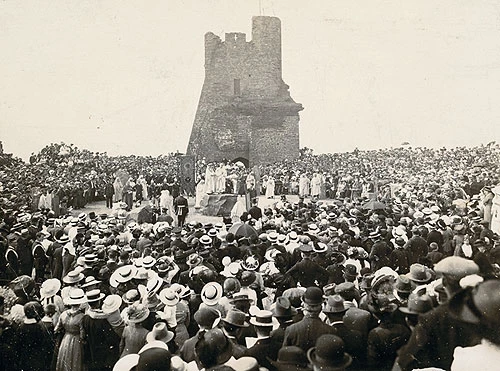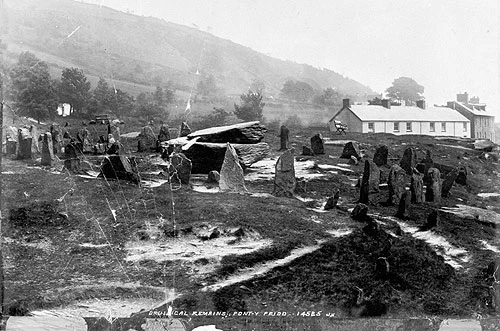The Gorsedd Circle
A huge crowd watching a ceremony in the Gorsedd Circle, in the Castle grounds, Aberystwyth, either during the Proclamation Ceremony, 1914 or during the Eisteddfod week itself, 1916.
The Maen Chwŷf and Gorsedd Stones, Pontypridd
The Proclamation Ceremony for the Newport and District National Eisteddfod, 1987 with Elerydd (W.J.Gruffydd) as Archdruid and Gwyn Tre-arth leading the singing on the Logan Stone.
Successful young candidates (13-14 years old) in the Gorsedd examinations, invested as members in Swansea, 1962.
The Proclamation Ceremony
The visit of the National Eisteddfod and the Gorsedd of the Bards to a specific area has to be proclaimed at least a year and a day in advance. During the ceremony the Recorder reads the Proclamation Scroll and the first copy of the list of competitions for the following year's National Eisteddfod is presented to the Archdruid.
When Lord Rhys held a competition for poets and musicians at his court in Cardigan castle in 1176 it was noted that it had been proclaimed throughout Wales, Scotland, Ireland, England and the other islands a year in advance. This custom was revived when eisteddfodau were re-established in Wales at the end of the eighteenth century and likewise, in 1791, Iolo Morganwg chose to proclaim that the Gorsedd of the Bards of the Isle of Britain would hold its first ceremony on Primrose Hill, London, on June 21, 1792. This pattern has been adhered to ever since.
From pebbles to fake stones
The Proclamation Ceremony and other Gorsedd ceremonies held during the week of the National Eisteddfod are held within the Gorsedd Stone Circle.
The remarkable stone remains at Avebury in Wiltshire and Dyffryn Golych, in his native county, probably influenced Iolo Morganwg's vision of a Celtic druidic stone circle. Thus, the first Gorsedd in 1792 was held within a circle of stones, with a Maen Gorsedd at its centre. However when Iolo came to link the Eisteddfod and the Gorsedd at Carmarthen in 1819 all he had to hand was a fistful of pebbles. Only Bards were allowed within this sacred circle of stones.
In Glamorganshire the Maen Chwŷf, a huge slab of slate stone, near Eglwysilan, was seen as a natural gorsedd and several meetings of the Glamorgan Chair were held on it during the first half of the nineteenth century.
Towards the end of the century, in order to inform future gorseddau, the Herald Bard - Arlunydd Pen-y-garn made a detailed plan of the Gorsedd Circle, and this was followed in the Cardiff Eisteddfod, 1899. According to this plan the stone to the east, the Maen Cyfamod, and the two Portal stones formed the shape of the mystic mark. For a time it was fashionable to dress the stones with oak and mistletoe leaves. To facilitate holding the Gorsedd Circle on the Eisteddfod field itself during the week of the Eisteddfod, it was decided in 2004 to use fake (but realistic-looking) stones.
The Circle during Eisteddfod week
The Monday morning rites
The Hirlas Horn (the horn of plenty) is presented to the Archdruid and the Celts and other representatives from abroad are welcomed by the Gorsedd. The Recorder commemorates those Gorseddogion who have died during the past year and a hymn of remembrance is sung. Then the ceremony of admitting new members through examination or degree to the Order of Ovates or Order of Bards takes place.
The Friday morning rites
The Blodeuged (the gift of flowers) is presented to the Archdruid and the Floral Dance is performed. New honorary members are admitted to the Order of Druids in Gorsedd.
Admitting new members
The Gorsedd of the Bards has three orders/degrees:
- The Order of Ovates: in green robes. Candidates who pass Levels 1 and 2 in Gorsedd examinations in poetry, prose, music, or the tests for harpists and singers are admitted into this order. Members can be admitted to the order as honorary members for contributions of national significance. Several members of the royal family, including Queen Elizabeth, the Duke of Edinburgh and King George, have been admitted to this Order.
- The Order of Bards, in blue robes. Those who have passed the final Gorsedd examination are admitted to this order. Those who have gained a degree in Welsh or Music (and who can speak Welsh) can also be admitted.
Members are admitted to these orders during the Monday morning ceremony in the Gorsedd Circle. The Herald Bard and the Bearer of the Grand Sword walk towards the entrance to the Circle and hold the Sword across it to bar the way. Every new member places his/her right hand on the Sword's blade. After a new member has been admitted he/she is led by the Marshalls to the Mistress of the Robes to be invested with his/her Order's head-dress. - The Order of Druids: in white robes. The winners of the main competitions - the Chair, the Crown and the Literary Medal - are admitted automatically to this Order. Others are 'elevated' to be Druids from the green or blue Orders. Every year, too, those who have served the nation, the Welsh language and its culture are honoured by being admitted to the Order of Druids, among them world-famous singers and actors such as Bryn Terfel, Sian Phillips and Ioan Gruffudd; influential Welshmen such as the Archbishop of Canterbury, the Right Reverend Rowan Williams and star footballers and rugby players.
Iolo differentiated between the bardic orders in the first Gorsedd ceremony in 1792 although he also emphasised that they should be considered equal in status. By the second half of the nineteenth century there was real concern regarding the merit of Gorsedd degrees. The scholar, John Morris-Jones, was the severest critic, because, he claimed, 'candidates are admitted as members through an examination which is five times easier than the most basic University of Wales examination ...'. As a result candidates came to be examined more stringently in order to raise standards.




Comments - (1)
1.the Gorsedd ( Throne ) Circle in front of the National Museum & Art Gallery in Cardiff was erected in 1899, that's right isn't it?
2.the Gorsedd Circle standing in the nearby Coopers Field, slightly to the west of today's Cardiff Castle was erected in what year, please?
3.in 1908 (?) the Welsh National Eisteddfod's Maes was the Royal Albert Hall -I believe, consequently where did the organisers put the Gorsedd Circle for that year's event, please?
& 4.when was the last and final stone 'henge' [ i.e. long-lasting and definitely of stone ] erected to commemorate the selection main event site of an Eisteddfod? -I mean, where is it to be seen? And in what year was it constructed, please?
If you'd answer the above questions, then I would be most obliged to you all.
Many, Many Thanks, Gerry Lyons, Cardiff, Wales.